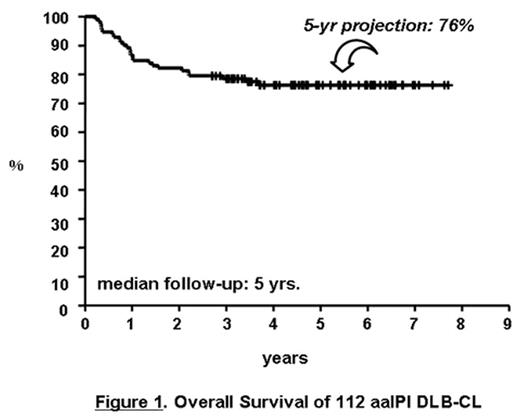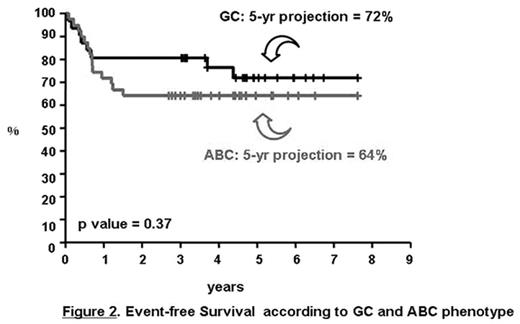Abstract
Background The outcome of Diffuse Large B Cell Lymphoma (DLB-CL) has been definitely improved by the addition of the anti-CD20 rituximab to conventional chemotherapy. However, despite the advantages offered by rituximab, results are still disappointing in patients presenting with adverse prognostic factors. For these patients, rituximab-supplemented intensive programs with autograft might represent a suitable option. Thus, a prospective multicenter study has been performed using first-line the Rituximab-supplemented high-dose sequential chemotherapy program delivered with multiple autologous peripheral blood progenitor cell (PBPC) support (R-HDS-maps regimen), in DLB-CL patients with score 2 or 3 according to the age-adjusted International Prognostic Index (aaIPI). Preliminary results have been already reported (ASH 2005;
Methods. R-HDS-maps includes:
3 APO courses;
sequential administration of hd-cyclophosphamide (CY), hd-Ara-C, both supplemented with Rituximab, hd-etoposide/Cisplatin, with PBPC harvests following hd-CY and hd-Ara-C;
hd-Mitoxantrone/L-Pam + 2 further Rituximab doses;
involved-field radiotherapy.
PBPC rescue was scheduled following Ara-C, etoposide/Cisplatin and Mitoxantrone/L-Pam. Six GITIL Centers participated in the multicenter study, with patients enrolled between November 1999 and September 2004.
Results. Overall, 112 consecutive patients (74 score 2, 38 score 3) entered the study protocol. There were 5 early toxic deaths (3 sepsis, 1 pneumonia, 1 JC-virus leucoencephalopathy) + one late toxic death due to pneumonia, at 10 mos.; two more patients died for secondary myelodysplastic syndrome at 3.4 and 3.6 yrs. As reported in Figures 1–2, at a median follow-up of 59 mos., 86 patients (77%) are alive; 79 (70%) are in continuous CR, with a 5-yr event-free survival (EFS) projections of 69%; no significant differences in OS and EFS between subgroups with Germinal-Center and Activated B-cell phenotype were observed.
Conclusions. R-HDS-maps regimen:
is feasible in a multicenter setting, with a toxicity similar to that of other dose-intense/high-dose regimens;
offers prolonged survival to most patients with aaIPI 2–3 DLB-CL.
Its comparative efficacy versus R-CHOP-14 is being tested in an ongoing GITIL phase III study.
Author notes
Disclosure:Research Funding: Some of the Authors have received financial research supports by Roche, Sanofi-Synthelabo and Italfarmaco. Honoraria Information: Some of the authors have been paid as invited speakers at national and international symposia. Off Label Use: The combined use of rituximab and hig-dose therapy with autograft as first line therapy for diffuse large B-cell lymphoma is discussed.



This feature is available to Subscribers Only
Sign In or Create an Account Close Modal